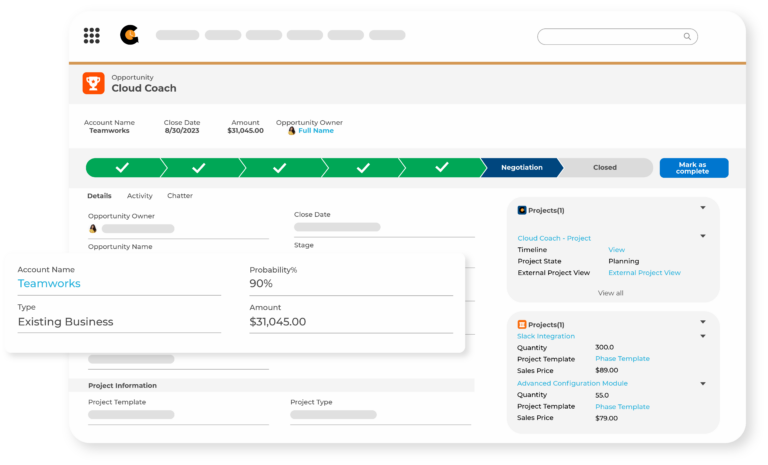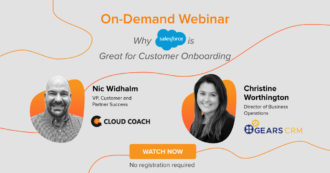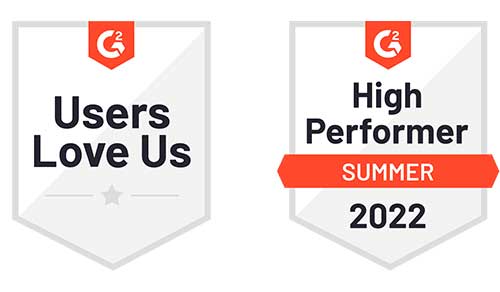 Webinar
Webinar
- Solutions
- Customer Onboarding
- Customer Success
- Professional Services Automation
- Project Management
- Project Portfolio Management
-
Solutions
-
Features
- Why Cloud Coach
- Customers
-
Resources

As clients move through their buyer’s journey, the handoff from sales to customer success serves a crucial role in their lifecycle.
The transition is much more than simply passing a baton. It involves a comprehensive knowledge transfer, personalized engagement, and regular follow-ups. With so many moving parts, there’s a lot of scope for it to go wrong!
A well-structured handoff process sets the tone for your future customer relationship. It guarantees your customers can see value continuously from their investment, and the results can be huge. Reducing the possibility of churn, improving the chance of customer retention and enhancing overall customer satisfaction.
So, how do you get this crucial exchange of information right?
The role of a CRM in the Sales to Customer Success Handoff
At its simplest level, the Sales to Customer Success handover is an exchange of information. Frequently, it’s the exchange of a HUGE amount of information.
The first step is making sure you are recording everything accurately, from the start of the sales process. Context is king – and your CRM has a critical role to play in the process.
Approximately 80% of Fortune 500 companies use Salesforce. If you’re reading this, there’s a very real chance that you’ll be using Salesforce in your day-to-day work, whatever your role. Whether it’s recording information on your prospects or your existing customers.
Salesforce is a powerful tool for recording customer and prospect data due to its comprehensive features tailored for efficient customer relationship management. Its centralized data management system serves as a singular hub, ensuring that all customer and prospect information is stored cohesively, eliminating data silos and enabling a holistic understanding of interactions.
If your Sales reps are capturing information correctly in Salesforce, then you have the building blocks in place for the perfect sales to customer success handoff!
ADDITIONAL LINKS
Sales To Customer Success Handoff in Salesforce
The temptation is often to introduce another siloed tool to help with the handover process – however, that’s not always the best approach! In order to perfect the handoff process, you need to make your data work harder.
During the sales cycle, your sales team will have spent time collecting customer information, contacts, budget information and even project requirements. For the most seamless handoff to your CS team, you need data to be accurate, up-to-date and, most importantly, safe.
You should aim for a handover process that removes unnecessary risk and moves your data off-platform to another third-party solution: and the key to that is finding a Salesforce-native solution to manage your customer journey.

Why use a Salesforce-native solution for the Sales to Service Handoff
Using a Salesforce-native solution for managing the sales to customer success handoff offers several compelling advantages.
Firstly, native integration ensures seamless data flow between sales and customer success teams within the Salesforce ecosystem, eliminating data silos and promoting a unified customer view. This integration facilitates real-time updates, enhancing communication and collaboration.
Additionally, a Salesforce-native solution leverages the platform’s customization capabilities, allowing businesses to tailor processes to their unique requirements. This adaptability ensures a more efficient and personalized handoff experience. Furthermore, utilizing a Salesforce-native solution often results in a smoother implementation process and ongoing support, as it aligns closely with the Salesforce architecture and updates. Ultimately, the native approach enhances efficiency, collaboration, and the overall effectiveness of the sales to customer success transition.
The power of automation in your sales to customer success handoff
A smooth transition from sales to customer success is characterized by seamless communication and a clear understanding of the customer’s needs and goals. It starts with the sales team providing comprehensive and accurate information about the customer’s requirements, preferences, and any ongoing issues. This information is then seamlessly transferred to the customer success team, ensuring that they have all the necessary details to provide personalized and effective support.
Automation plays a crucial role in this process, streamlining the handoff and reducing the chances of miscommunication or missed information. By automating the transfer of customer data from the sales team to the customer success team, valuable time is saved, and the risk of human error is minimized. This allows the customer success team to quickly pick up where the sales team left off, without any delays or confusion.
Furthermore, automation can also be utilized to trigger specific actions or tasks based on predefined criteria. For example, if a customer has a specific issue or request, an automated workflow can be set up to assign it to the most appropriate customer success representative, ensuring that it is addressed promptly and efficiently. This not only improves response times but also enhances customer satisfaction and loyalty.
In addition to automation, effective collaboration between the sales and customer success teams is essential for a smooth transition. Regular communication, shared goals, and a mutual understanding of each team’s responsibilities are key to ensuring a seamless handoff. This can be facilitated through the use of collaborative tools and platforms, such as shared project management systems or communication channels, where both teams can easily access and update relevant information.
Ultimately, a smooth transition from sales to customer success is a result of a well-coordinated and efficient process. By leveraging automation, enhancing collaboration, and utilizing a Salesforce-native solution, businesses can optimize their handoff experience, leading to improved customer satisfaction, increased retention rates, and ultimately, long-term success.
So, what does a smooth transition from sales to customer success actually look like?
Sometimes, the most thorough handoff can also be the most simple.
If you are using Salesforce and Cloud Coach for both your sales processes and customer success processes, you can turn your opportunities into projects from just a single click.

With project information recorded in Salesforce, you can ensure your team is in the ideal position to get to work, even before the opportunity has been closed.
By adding placeholder information, you can ensure your entire team has the capacity required to complete a project – keeping your clients happy from the start, and giving your customer success teams the best possible chance of success.

Using Cloud Coach for your handover and onboarding process
Cloud Coach, a Salesforce-native customer journey solution, allows for seamless transition between sales and customer success teams. This ensures that all relevant details about the customer’s journey, including sales interactions, requirements, and expectations, are accessible to the customer success team.
Automated Workflows: Project management tools often come with automation features that enable the creation of workflows. These workflows can automate the handoff process, triggering specific actions or notifications when a deal is won. This ensures that the customer success team is promptly informed and can initiate their processes without delays.
Task Assignment and Tracking: Cloud Coach may facilitate the assignment of tasks related to customer onboarding or post-sales activities. This helps in clearly defining responsibilities during the handoff and allows for easy tracking of progress by both sales and customer success teams.
Timeline and Milestone Management: Effective handoffs require a clear understanding of timelines and milestones. Cloud Coach might provide tools for creating and managing project timelines, ensuring that both teams are aligned on the expectations and deliverables during the transition from sales to customer success.
Reporting and Analytics: Robust reporting and analytics within project management tools can offer insights into the efficiency of the handoff process. Teams can analyze key performance indicators to identify areas for improvement and optimize the transition from sales to customer success.
Conclusion And Tips To Improve Sales To Customer Success Handoff
Facilitating a smooth sales to customer success handoff is key to customer retention and satisfaction.
Here are some tips to improve the sales to customer success handoff and ensure a seamless transition:
- Communication is crucial: Establish open lines of communication between the sales and customer success teams. Regular meetings and updates can help both teams stay informed about the progress of the handoff and address any potential issues or concerns.
- Define clear timelines and milestones: Set clear expectations and deadlines for each stage of the handoff process. This will help both teams stay on track and ensure that all deliverables are met in a timely manner.
- Utilize project management tools: Take advantage of project management tools, like Cloud Coach, to create and manage project timelines. These tools can help track progress, assign tasks, and keep both teams aligned on the goals and objectives of the handoff.
- Monitor and analyze performance: Use reporting and analytics features within project management tools to monitor the efficiency of the handoff process. Identify key performance indicators, such as response time or customer satisfaction, and analyze the data to identify areas for improvement.
- Foster collaboration and knowledge sharing: Encourage collaboration between the sales and customer success teams. This can be done through cross-functional training sessions or shared documentation. By sharing knowledge and insights, both teams can better understand each other’s roles and responsibilities, leading to a smoother handoff.
A successful sales to customer success handoff is essential for customer retention and satisfaction. By implementing these tips and utilizing the right tools, teams can improve the handoff process, enhance communication, and ultimately provide a seamless experience for customers.
Using templates, playbooks, and guides significantly eases the transition, but the key to perfecting the process is leaving no room for communication gaps. When no data falls through the cracks, you can eliminate pain points, both internally and externally.
By focusing on perfecting this transition, businesses can set the groundwork for long-term success and improve overall customer experience. Now, it’s over to you – are you doing all you can to optimize your sales to customer success handoff?
If you would like to find out more about how Cloud Coach can help you, speak to us today!
Helpful Resources
See Cloud Coach In Action
We’d be happy to provide a bespoke 1:1 demo on how Cloud Coach can benefit for your business.























